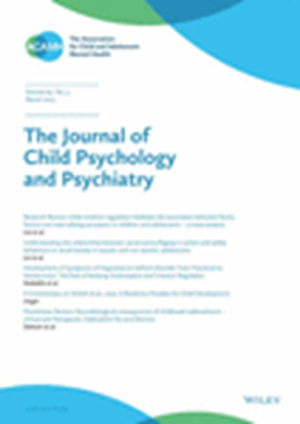早产学龄前儿童注意力问题的发展轨迹
IF 6.5
1区 医学
Q1 PSYCHIATRY
引用次数: 0
摘要
背景早产儿神经发育受损的风险较高,其中包括注意力方面的特殊缺陷。很少有研究调查入学前注意力问题随时间的变化。本研究旨在描述一组胎龄 30 周(GA)的早产儿从 2 岁到 5 岁期间注意力问题的变化轨迹,确定与注意力变化轨迹相关的社会人口学、医学和神经行为学特征,并检验注意力问题变化轨迹是否能预测注意力缺陷/多动障碍(ADHD)的诊断风险。方法我们研究了608名来自极早产儿新生儿神经行为和结果(NOVI)研究的婴儿,该研究是一项前瞻性、多地点研究,对象是出生后30周的婴儿。家长使用儿童行为检查表和儿童行为评估系统报告了孩子在 2、3、4 和 5 岁时的注意力问题。社会人口学和医学特征通过母亲访谈和病历审查进行评估。神经行为特征则通过新生儿和两岁评估来确定。我们还获得了家长对儿童多动症诊断的报告。我们使用潜在成长曲线(LGC)模型来检验我们的研究目的。注意力问题的平均轨迹显示,最初的症状水平较低,随着时间的推移变化不大,但最初的症状水平和随着时间的推移变化都存在显著的异质性。轨迹参数的个体差异与社会人口学、医学、环境和神经行为特征有关。最初注意力问题水平较高以及随着时间推移注意力问题急剧增加的儿童更有可能被诊断为多动症。结论出生后30周的儿童从2岁到5岁注意力问题的轨迹存在显著的异质性,这些差异具有临床意义。这些数据可为早产儿随访指南提供参考。本文章由计算机程序翻译,如有差异,请以英文原文为准。
Trajectories of attention problems in preschoolers born very preterm
BackgroundChildren born preterm are at heightened risk for neurodevelopmental impairment, including specific deficits in attention. Few studies have investigated change over time in attention problems prior to school entry. The current study aims to describe trajectories of attention problems from age 2 through 5 years in a cohort of children born <30 weeks of gestational age (GA), identify sociodemographic, medical, and neurobehavioral characteristics associated with attention trajectories, and test whether attention problem trajectories predict the risk of a reported attention‐deficit/hyperactivity disorder (ADHD) diagnosis.MethodsWe studied 608 infants from the Neonatal Neurobehavior and Outcomes in Very Preterm Infants (NOVI) Study, a prospective, multisite study of infants born <30 weeks of GA. Parents reported on child attention problems at ages 2, 3, 4, and 5 years using the Child Behavior Checklist and the Behavior Assessment System for Children. Sociodemographic and medical characteristics were assessed via maternal interview and medical record review. Neurobehavioral characteristics were determined using neonatal and 2‐year assessments. Parent report of child ADHD diagnosis was obtained. We used latent growth curve (LGC) modeling to test our study aims.ResultsA linear LGC model provided the best fit to the data. The average trajectory of attention problems evidenced low initial levels of symptoms and little change over time, yet there was significant heterogeneity in both initial levels and change over time. Individual differences in trajectory parameters were associated with sociodemographic, medical, environmental, and neurobehavioral characteristics. Children with higher initial levels of attention problems as well as steeper increases in attention problems over time were more likely to have a reported ADHD diagnosis.ConclusionsThere is significant heterogeneity in trajectories of attention problems from age 2 to 5 in children born <30 weeks of GA and these differences have clinical relevance. These data could inform follow‐up guidelines for preterm infants.
求助全文
通过发布文献求助,成功后即可免费获取论文全文。
去求助
来源期刊
CiteScore
13.80
自引率
5.30%
发文量
169
审稿时长
1 months
期刊介绍:
The Journal of Child Psychology and Psychiatry (JCPP) is a highly regarded international publication that focuses on the fields of child and adolescent psychology and psychiatry. It is recognized for publishing top-tier, clinically relevant research across various disciplines related to these areas. JCPP has a broad global readership and covers a diverse range of topics, including:
Epidemiology: Studies on the prevalence and distribution of mental health issues in children and adolescents.
Diagnosis: Research on the identification and classification of childhood disorders.
Treatments: Psychotherapeutic and psychopharmacological interventions for child and adolescent mental health.
Behavior and Cognition: Studies on the behavioral and cognitive aspects of childhood disorders.
Neuroscience and Neurobiology: Research on the neural and biological underpinnings of child mental health.
Genetics: Genetic factors contributing to the development of childhood disorders.
JCPP serves as a platform for integrating empirical research, clinical studies, and high-quality reviews from diverse perspectives, theoretical viewpoints, and disciplines. This interdisciplinary approach is a key feature of the journal, as it fosters a comprehensive understanding of child and adolescent mental health.
The Journal of Child Psychology and Psychiatry is published 12 times a year and is affiliated with the Association for Child and Adolescent Mental Health (ACAMH), which supports the journal's mission to advance knowledge and practice in the field of child and adolescent mental health.

 求助内容:
求助内容: 应助结果提醒方式:
应助结果提醒方式:


